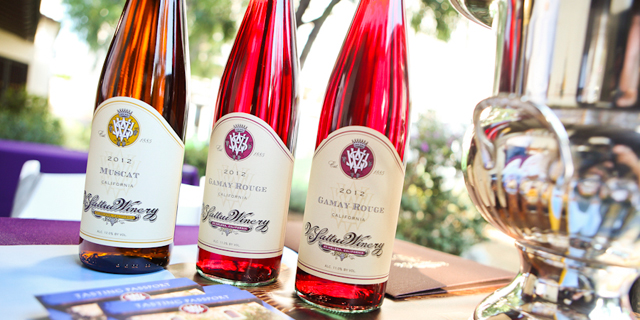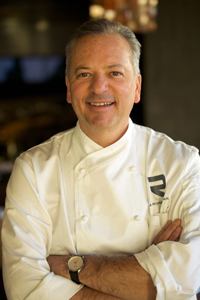It’s a typical summer evening at Union Station in downtown Los Angeles, sizzling with the energy of summer tourists just arriving and locals heading out of town. But on this Friday night, the strains of a live salsa band permeate the air with a festive beat, while a dressed-up crowd follows the music, filing into a private courtyard.
Wineglasses in hand, these visitors aren’t boarding a train. They’re striking out on a journey of a different kind—a three-hour culinary adventure with a Latin flavor. East LA Meets Napa and Beyond brings together Mexican-American winemakers and some of Los Angeles’s best Latin restaurants to raise funds for AltaMed, a nonprofit network of community health clinics in Southern California. The “beyond” includes vintners from Mexico’s Valle del Guadalupe, a fitting way to expand the successful event’s scope.
One of the first food and wine tastings to shine the spotlight on the storied Napa Valley’s Latino heritage, the event boasts an ever-growing following and even inspired two UCLA professors to launch a study on Mexican and Latino contributions to the wine industry in Northern California.
Although California’s commercial winemaking industry actually began in 1830s Los Angeles a few blocks from present-day Union Station, Mexican and Chinese laborers were brought to Napa and Sonoma counties to maintain the vineyards that began proliferating during California’s Gold Rush in the late 1840s.
Today, many of Napa and Sonoma counties’ Latino winemakers can trace their roots to a second wave of Mexican laborers who arrived in the Napa Valley as part of the Mexican Farm Labor Program of 1942. One of them is Vanessa Robledo, president and partner of Black Coyote Wines and one of the first Latina winemakers to participate in East LA Meets Napa.
“My ancestors came here as braceros,” she says. “Many of the old vines in Napa and Sonoma were grafted by Robledos.”
Next up, a look at the delicious dishes served up for East LA Meets Napa…
[pagebreak]In addition to showcasing wines by Mexican-American wineries, East LA Meets Napa gives Latin food lovers a chance to try wine as an alternative to beer or tequila when enjoying traditional Mexican and Central and South American dishes.
“Latinos used to drink cerveza with [Latin American food],” says chef John Sedlar (right) of Rivera restaurant in downtown Los Angeles, one of the Latino chefs who has participated in the event since its inception. “But they’re discovering that the complexity of wine goes well with Latin American cuisine.”
Case in point: a Peruvian cebiche served at this year’s event by chef Hugo Molina of Seta restaurant in Los Angeles County. Molina’s team dished out samples as fast as they could to keep up with the throngs of visitors waiting for a taste of the delicate fish in its zesty leche de tigre (the juice from the lemon marinade). At a nearby table, Gerardo Espinosa Jr., proprietor and winemaker at Viñedos Aurora, offered up samples of his 2010 Albariño, with delicate tropical fruit flavors that happened to pair beautifully with Molina’s cebiche.
With 30 restaurants and 30 wineries represented this year, the setting is ripe for such serendipitous pairings.
Staff from Rocío’s Mole de los Dioses, one of two L.A. Oaxacan restaurants recognized in LA Times food critic Jonathan Gold’s 2013 “101 Best Restaurants in Los Angeles” list, plied attendees with samples of their award-winning moles. The smoky richness of the mole sauce was the perfect complement to the Pinot Noirs being poured by wineries with vineyards in Napa and Sonoma counties’ cooler regions.
“Events like these make you want to continue creating and bringing a touch of what you do to everyone,” says Molina.
Sedlar adds, “I think the entire world is opening up to everything Latino—the food, the fashion, the music. It’s an extraordinary place to be in the universe right now.”
Next, get a taste of the event with a recipe from John Sedlar…
[pagebreak]
- 1 1/4 pounds dried corn
- 1 1/2 tablespoons slaked lime
- 4 quarts plus 3/4 cups water, divided
- 1 tablespoon sea salt
- organic edible flower petals
- 2 tablespoons olive oil




![Making Mealtime Matter with La Familia: Easy Sofrito [Video]](https://thelatinkitchen.com/wp-content/uploads/2015/10/sofrito-shutterstock__0-500x383.jpg)
![Easy Latin Smoothies: Goji Berry Smoothie [Video]](https://thelatinkitchen.com/wp-content/uploads/2015/12/goji_berry-shutterstock_-500x383.jpg)
















![Fun and Fast Recipes: Fiesta Cabbage Salad [Video]](https://thelatinkitchen.com/wp-content/uploads/2015/11/fiesta_cabbage_slaw-shutterstock_-500x383.jpg)









